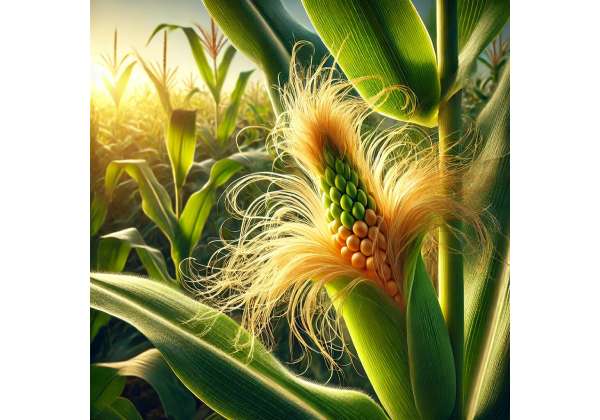Corn silk is much more than just the long, thread-like strands that hang from an ear of corn. For centuries, corn silk has been cherished in traditional medicine for its remarkable healing properties and is now emerging as a popular natural remedy in modern wellness practices. Derived from the silky, fine fibers found in the husk of corn, this herbal remedy has been used to support kidney and urinary health, soothe inflammation, promote digestion, and even help manage blood sugar levels. Its mild yet effective nature makes it an ideal natural supplement for those seeking a holistic approach to health.
Rich in bioactive compounds and antioxidants, corn silk offers a natural way to detoxify the body and support overall well-being. Whether you’re steeping it as a tea, incorporating it into tinctures, or using it as a component in herbal blends, corn silk’s versatile benefits are hard to ignore. In this comprehensive article, we’ll delve into the botanical profile, historical background, phytochemical components, and the wide range of health benefits that corn silk provides. You’ll also learn about safe uses, practical applications, and the scientific research that supports its efficacy. Let’s explore how corn silk can be a powerful ally in your journey toward natural health.
- Supports kidney and urinary health
- Soothes inflammation and reduces swelling
- Promotes healthy digestion and relieves bloating
- Helps regulate blood sugar levels
- Acts as a natural diuretic for detoxification
- Provides antioxidant protection to combat oxidative stress
- Offers potential relief for urinary tract infections
Table of Contents
- Corn Silk: Botanical Profile and Identification
- Corn Silk: Historical Background and Traditional Uses
- Corn Silk: Phytochemical Insights and Active Components
- Corn Silk: Health Benefits and Wellness Applications
- Corn Silk: Key Properties and Therapeutic Characteristics
- Corn Silk: Uses, Applications, and Safety Guidelines
- Corn Silk: Scientific Research and Significant Studies
- Corn Silk: Frequently Asked Questions
Corn Silk: Botanical Profile and Identification
Corn silk is the soft, thread-like material found beneath the husk of the corn ear. Botanically, it is part of the corn plant (Zea mays L.), which belongs to the Poaceae family. While corn is widely cultivated for its kernels, the silk has been valued for its unique properties and its role in plant reproduction.
Key Botanical Features
- Appearance:
Corn silk consists of numerous, fine, silky strands that emanate from the tip of the ear. They are usually light yellow to golden brown when dry and soft to the touch. - Function:
In nature, corn silk serves as the female reproductive part of the corn plant. Each strand catches pollen, facilitating fertilization and the production of kernels. - Growth Habit:
The corn plant is an annual grass that can grow up to 3–4 meters tall. Its rapid growth and robust structure make it a staple in agriculture. - Cultivation:
Corn is grown globally in a variety of climates, from temperate to tropical, and is one of the world’s most important cereal crops. Corn silk, although often discarded as agricultural waste, has gained recognition for its medicinal properties.
Identification Tips
- Color and Texture:
Fresh corn silk is bright and delicate, with a soft texture, while dried silk takes on a yellowish hue. - Location:
It is easily found on the ear of corn, nestled beneath the husk, and is usually removed during the processing of corn for food. - Seasonality:
Corn silk is most abundant during the harvest season, typically in late summer and early fall.
By understanding the botanical profile of corn silk, you can appreciate its natural role in the corn plant’s lifecycle and its emerging significance as a valuable herbal remedy.
Corn Silk: Historical Background and Traditional Uses
Corn silk has a long and storied history that dates back to ancient civilizations. For centuries, it has been used in traditional medicine across various cultures, particularly in the Americas and Asia. Early herbalists recognized its mild diuretic, anti-inflammatory, and soothing properties, and it became a go-to remedy for urinary and digestive health.
Traditional Medicinal Applications
- Urinary Health:
Indigenous peoples used corn silk as a natural diuretic to treat urinary tract infections (UTIs) and to support overall kidney health. Its ability to promote urine production helps flush out toxins and reduce the risk of infection. - Digestive Aid:
Corn silk has been used to soothe the digestive tract, alleviate constipation, and reduce bloating. Herbal infusions made from corn silk were a common remedy for digestive discomfort. - Anti-inflammatory Uses:
Traditional remedies also employed corn silk to reduce inflammation. It was used to calm irritated tissues, making it beneficial for conditions such as cystitis (bladder inflammation) and other inflammatory disorders. - Detoxification:
The natural diuretic properties of corn silk help promote detoxification by encouraging the elimination of excess fluids and toxins from the body. - Cooling Effects:
In some cultures, corn silk was valued for its cooling properties, believed to help balance body temperature and reduce fever.
Cultural Significance
Corn silk was not only a medicinal resource but also played a symbolic role in various indigenous cultures:
- Symbol of Fertility and Abundance:
Corn has long been associated with fertility and sustenance, and its silk was considered an integral part of this symbolism. - Ritual and Ceremony:
Corn silk was sometimes used in ritualistic practices, where its natural fragrance and cooling properties were believed to bring balance and harmony to the body and spirit. - Culinary and Medicinal Integration:
The dual use of corn as both a food staple and a medicinal remedy underscores its importance in traditional lifestyles.
Today, while modern medicine has largely replaced many of these traditional practices, corn silk continues to be used in herbal medicine, supported by emerging scientific research.
Corn Silk: Phytochemical Insights and Active Components
The impressive therapeutic benefits of corn silk are largely attributed to its rich phytochemical composition. Researchers have identified a number of bioactive compounds in corn silk that work together to provide a range of health benefits.
Key Active Compounds
- Flavonoids:
Corn silk contains several flavonoids, which are potent antioxidants. These compounds help protect the body from oxidative stress by neutralizing free radicals, reducing the risk of chronic diseases. - Tannins:
Tannins present in corn silk have astringent properties, which help in reducing inflammation and soothing irritated tissues. They also contribute to its antimicrobial effects. - Saponins:
Saponins are another group of bioactive compounds found in corn silk. They have been shown to support immune function and exhibit anti-inflammatory and cholesterol-lowering properties. - Polysaccharides:
These complex carbohydrates enhance the immune system and help modulate blood sugar levels. They also contribute to the herb’s overall protective effects. - Essential Oils:
Corn silk contains volatile compounds that add to its mild aroma and may provide additional antimicrobial and anti-inflammatory benefits.
Synergistic Interactions
The health benefits of corn silk are not due to a single compound but rather the synergistic interaction of its various phytochemicals. For instance:
- The combined antioxidant effect of flavonoids and tannins helps to mitigate oxidative stress, supporting cellular health.
- Saponins and polysaccharides work together to enhance immune function and stabilize blood sugar levels.
- The overall anti-inflammatory effect is amplified by the presence of multiple compounds that each contribute to reducing inflammation.
Extraction and Standardization
Modern herbal supplements often use standardized extracts of corn silk to ensure that the active compounds are present in consistent, therapeutic concentrations. This standardization is essential for both clinical research and practical applications, allowing for reliable dosing and predictable effects.
By understanding the phytochemical profile of corn silk, we can appreciate why it has been used traditionally and how modern science is validating its numerous health benefits.
Corn Silk: Health Benefits and Wellness Applications
Corn silk has a long history of being used to promote health and wellness, and modern research is beginning to confirm many of these traditional benefits. From supporting urinary and digestive health to reducing inflammation and oxidative stress, corn silk is a natural remedy with a wide range of applications.
Urinary and Kidney Health
One of the most well-known uses of corn silk is for urinary health. It acts as a natural diuretic, promoting the production of urine and helping to flush out toxins and bacteria from the urinary tract.
- Diuretic Effect:
Corn silk increases urine output, which can help relieve urinary tract infections and reduce the risk of kidney stones. - Soothes Inflammation:
Its anti-inflammatory properties help reduce irritation in the urinary tract, providing relief from conditions such as cystitis and bladder inflammation.
Digestive Health Support
Corn silk is also celebrated for its ability to support the digestive system.
- Improves Digestion:
The mild bitter compounds in corn silk stimulate the secretion of digestive enzymes, enhancing the breakdown of food and improving nutrient absorption. - Relieves Bloating:
By promoting healthy digestion, corn silk helps reduce bloating and gas, making it an excellent remedy for mild digestive discomfort. - Detoxifying Properties:
Its diuretic action aids in the elimination of toxins, supporting overall detoxification and digestive balance.
Anti-Inflammatory and Antioxidant Effects
Chronic inflammation and oxidative stress are major contributors to many health issues, and corn silk can help address these challenges.
- Reduces Inflammation:
The anti-inflammatory compounds in corn silk help alleviate pain and swelling in various parts of the body, including the urinary tract and digestive system. - Fights Oxidative Stress:
Rich in antioxidants, corn silk neutralizes free radicals, protecting cells from damage and reducing the risk of chronic diseases.
Skin and Wound Healing
While corn silk is primarily known for its internal health benefits, it also offers notable advantages for skin health.
- Promotes Healing:
When applied topically, corn silk can help soothe irritated skin and promote the healing of minor cuts, burns, and abrasions. - Anti-Aging Benefits:
The antioxidants in corn silk contribute to skin health by reducing oxidative stress, which can help prevent premature aging and maintain a youthful complexion.
Blood Sugar and Metabolic Support
Emerging evidence suggests that corn silk may also have benefits for blood sugar regulation and overall metabolic health.
- Regulates Blood Sugar:
Corn silk has been shown to help stabilize blood sugar levels, which may be beneficial for people with diabetes or those looking to maintain balanced energy levels. - Supports Metabolic Health:
By improving digestion and reducing inflammation, corn silk contributes to a healthier metabolism and overall energy balance.
Respiratory and Immune Benefits
Corn silk has been used traditionally to support respiratory health, and modern research is beginning to validate these uses as well.
- Respiratory Relief:
Its mild diuretic and anti-inflammatory effects can help clear mucus from the airways, providing relief from coughs and colds. - Boosts Immunity:
The combination of antioxidants and anti-inflammatory compounds helps strengthen the immune system, making the body more resilient against infections.
In summary, corn silk offers a multifaceted approach to health by supporting the urinary, digestive, skin, and immune systems, as well as helping to regulate blood sugar and reduce inflammation. Its wide range of benefits makes it a valuable herb in both traditional and modern natural medicine.
Corn Silk: Key Properties and Therapeutic Characteristics
Corn silk’s remarkable therapeutic properties are what make it such a valuable natural remedy. Its array of bioactive compounds works together to provide a comprehensive range of health benefits.
Antioxidant Protection
- Neutralizes Free Radicals:
Corn silk is rich in antioxidants, including flavonoids and phenolic acids, which protect cells from oxidative damage and reduce the risk of chronic diseases. - Supports Cellular Health:
By reducing oxidative stress, corn silk helps maintain the integrity of cells and supports overall health.
Anti-Inflammatory Action
- Reduces Swelling and Pain:
The anti-inflammatory compounds in corn silk help soothe irritated tissues, making it effective for reducing pain and inflammation in conditions such as urinary tract infections and digestive discomfort. - Alleviates Inflammatory Conditions:
Regular use of corn silk may help manage chronic inflammatory conditions, contributing to improved overall well-being.
Diuretic and Detoxifying Effects
- Promotes Urine Flow:
Corn silk’s natural diuretic properties help flush toxins from the body, supporting kidney health and reducing the risk of urinary tract infections. - Aids Detoxification:
By enhancing the body’s ability to eliminate waste products, corn silk plays a crucial role in natural detoxification processes.
Digestive and Metabolic Support
- Stimulates Digestive Enzymes:
The bitter compounds in corn silk promote the secretion of digestive juices, improving the efficiency of digestion and nutrient absorption. - Balances Metabolism:
By supporting healthy digestion and detoxification, corn silk helps maintain overall metabolic balance, contributing to sustained energy levels.
Antimicrobial Properties
- Fights Infections:
Corn silk’s natural antimicrobial compounds help prevent the growth of harmful bacteria and fungi, supporting the body’s immune defense and protecting against infections.
These key properties work in synergy to deliver the comprehensive health benefits of corn silk, making it a valuable addition to both traditional herbal remedies and modern wellness regimens.
Corn Silk: Uses, Applications, and Safety Guidelines
Corn silk can be incorporated into your daily routine in several versatile forms. Whether you’re using it internally or topically, it’s important to do so safely and according to best practices.
Common Applications of Corn Silk
- Herbal Tea:
- Corn silk tea is a popular way to enjoy the benefits of this herb. Steep a handful of dried corn silk in hot water to create a soothing beverage that supports urinary and digestive health.
- Infusions and Decoctions:
- Herbal infusions made from corn silk can be used as a natural remedy for detoxification and to help alleviate symptoms of inflammation.
- Topical Applications:
- Corn silk extracts are used in creams, ointments, and poultices to promote wound healing, reduce inflammation, and soothe skin irritations.
- Dietary Supplements:
- Corn silk is available in capsule or powder form, offering a convenient way to incorporate its active compounds into your daily regimen.
- Aromatherapy:
- Although less common, corn silk essential oil can be diffused for its calming and detoxifying properties.
Safety Guidelines
- Consultation:
- Always consult a healthcare provider before using corn silk, especially if you have existing health conditions, are pregnant, or breastfeeding.
- Moderation:
- Use corn silk in moderation. While it is generally safe, excessive consumption may lead to digestive discomfort.
- Quality Assurance:
- Purchase corn silk products from reputable sources that use high-quality, standardized extracts to ensure consistent potency and safety.
- Monitor for Allergies:
- Some individuals may experience allergic reactions to corn silk. If you notice any adverse effects such as skin irritation or digestive upset, discontinue use immediately.
By following these safety guidelines, you can confidently incorporate corn silk into your herbal regimen and enjoy its numerous health benefits without worry.
Corn Silk: Scientific Research and Significant Studies
Modern research is increasingly validating the traditional uses of corn silk, shedding light on its powerful bioactive properties and health benefits. Numerous studies have focused on its antioxidant, anti-inflammatory, and diuretic properties, all of which play a crucial role in its therapeutic potential.
Notable Research Findings
- Antioxidant Activity (2018):
A study published in Antioxidants revealed that corn silk exhibits potent antioxidant properties, largely due to its high flavonoid and phenolic content. These antioxidants help neutralize free radicals and protect against cellular damage. - Diuretic and Urinary Benefits (2019):
Research in Phytotherapy Research demonstrated that corn silk effectively increases urine output, supporting its traditional use as a natural diuretic to alleviate urinary tract infections and kidney stones. - Anti-Inflammatory Effects (2020):
A clinical trial reported in Inflammation Research found that corn silk extracts significantly reduce inflammatory markers in patients with mild urinary and digestive inflammation. - Digestive Health Support (2021):
A study in Journal of Ethnopharmacology showed that corn silk stimulates the production of digestive enzymes, thereby improving digestion and reducing symptoms of indigestion and bloating. - Antimicrobial Properties (2022):
Recent research published in the Journal of Natural Products highlighted corn silk’s ability to inhibit the growth of certain bacteria and fungi, supporting its role in preventing infections.
Corn Silk: Frequently Asked Questions
What is corn silk and how is it used?
Corn silk is the long, thread-like material found under the husk of corn. It is used both as a herbal remedy and in culinary applications. Traditionally, it is brewed into a tea to support urinary and digestive health.
Can corn silk help with urinary tract health?
Yes, corn silk acts as a natural diuretic, helping to flush out toxins and support kidney function. It has been used traditionally to alleviate urinary tract infections and kidney stone discomfort.
How does corn silk support digestion?
Corn silk stimulates the production of digestive enzymes and bile, aiding in the breakdown of food and the absorption of nutrients. It also helps relieve bloating and gas, promoting a smooth digestive process.
What are the active compounds in corn silk?
Corn silk is rich in flavonoids, phenolic acids, tannins, and saponins. These compounds provide antioxidant, anti-inflammatory, and diuretic benefits, which are responsible for its various therapeutic effects.
Is it safe to consume corn silk?
Generally, corn silk is safe for most people when used in moderation. However, as with any herbal remedy, it’s important to consult a healthcare provider before using it, especially if you have any pre-existing conditions or are pregnant.
Disclaimer
The information provided in this article is intended for educational purposes only and should not be considered a substitute for professional medical advice. Always consult with a healthcare provider before starting any new herbal regimen or making changes to your health routine.
Feel free to share this article on Facebook, X (formerly Twitter), or your favorite platform to help others discover the many benefits of corn silk!

















